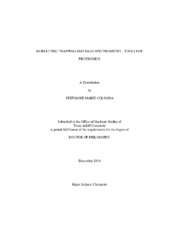| dc.description.abstract | Mass spectrometry (MS) has played a major role in the proteomic analysis of an
array of biological samples. Even so, inherent limitations exist such as sample
complexity and the dynamic range. In an attempt to overcome these limitations, prefractionation
is typically performed followed by reversed phase liquid chromatography
coupled with MS. Pre-fractionation can be performed in several formats including
chromatographic or electrophoretic based methods. Solution-based isoelectric point (pI)
fractionation, specifically isoelectric trapping (IET), provides an attractive alternative for
pre-fractionation in bottom-up proteomic studies.
A recently developed device, membrane separated wells for isoelectric focusing
and trapping (MSWIFT), provides rapid separation on the basis of pI and resulting
solutions are MS compatible without the need for extensive sample cleanup. Initial
experiments demonstrate fractionation using MSWIFT, of peptide mixtures ranging
from standards to a yeast lysate where resulting fractions are analyzed using matrixassisted
laser desorption/ionization (MALDI) – MS or further separated using reversed
phase liquid chromatography followed by tandem MS (MS/MS) analysis. Identified
yeast proteins range in size, pI and copy number illustrating an ability to increase the depth of proteome coverage when using MSWIFT. Extensive studies were also
performed using MSWIFT in a multi-stage fractionation platform to improve peptide
and protein identifications for the first large-scale proteomic study of the model fungus,
Neurospora crassa.
A second focus of this work is the development of a new sample preparation
method for proteolytic digestion and high-throughput separations using MSWIFT.
Histidine is used as a neutral pH, isoelectric, sample buffer for tryptic digestion of
proteins and also assists in rapid separations using MSWIFT owing to the low
conductivity. Tryptic digests of individual standard proteins and a mixture of standard
proteins are used to illustrate these advantages. Finally, the histidine buffer sample
preparation method is incorporated into a two-dimensional separation strategy. Tryptic
peptides are fractionated using MSWIFT and resulting solutions are further separated
using capillary electrophoresis (CE) coupled with MALDI-MS/MS. Performing the
two-dimensional strategy allows for increased confidence in peptide and protein
assignment owing to experimentally determined in-solution charge states and estimated
pI values. | en |


